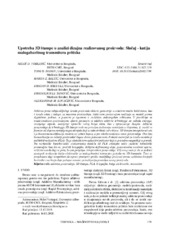Приказ основних података о документу
Upotreba 3D štampe u analizi dizajna realizovanog proizvoda - slučaj - kutija malogabaritnog transmitera pritiska
The usage of 3D printing in the analysis of the product design: Case: Electronic enclosure of compact pressure transmitter
| dc.creator | Vorkapić, Miloš | |
| dc.creator | Ivanov, Toni | |
| dc.creator | Baltić, Marija | |
| dc.creator | Kreculj, Dragan D. | |
| dc.creator | Tanović, Dragoljub Lj. | |
| dc.creator | Kovačević, Aleksandar M. | |
| dc.date.accessioned | 2022-09-19T19:01:22Z | |
| dc.date.available | 2022-09-19T19:01:22Z | |
| dc.date.issued | 2020 | |
| dc.identifier.issn | 0040-2176 | |
| dc.identifier.uri | https://machinery.mas.bg.ac.rs/handle/123456789/3321 | |
| dc.description.abstract | Aditivna proizvodnja uključuje izradu proizvoda složene geometrije u relativno malim količinama, kao i izradu alata i kalupa za masovnu proizvodnju. Aditivnom proizvodnjom realizuju se modeli prema digitalnom prikazu, a primena je ogromna u različitim industrijskim sektorima. U poređenju sa tradicionalnom proizvodnjom, glavni parametri u odabiru aditivne tehnologije su: ušteda energije, smanjenje otpada, smanjenje upotrebe većeg broja alata, kao i optimizacija dizajna. Aditivna proizvodnja ili tehnologija 3D štampe rade na principu dodavanja materijala u slojevima, tj. model se formira od slojeva rastopljenog materijala koji se odmah hladi i očvršćava. 3D štampa omogućava čestu i jednostavnu modifikaciju modela na zahtev kupca, a pre ulaska modela u samu proizvodnju. Ovo čini komunikaciju na relaciji proizvođač-kupac dosta jednostavnom. Polazni materijal za izradu modela je polilaktična kiselina (PLA). To je ekološki termoplastični poliester koji se prirodno razgrađuje u prirodi. Na mehaničke karakteristike realizovanog modela od PLA značajno utiču različite tehnološke promenljive kao što su: prečnik brizgaljke, debljina definisanog sloja, procentualna vrednost ispune, veličina uzorka koji se puni, brzina punjenja i temperatura proizvodnje. Cilj ovog rada je da se prikaže postupak realizacije kutije elektronike za malogabaritni transmiter pritiska na 3D štampaču. Time se projektantu daje mogućnost da ispravi postojeće greške, modifikuje proizvod prema zahtevima krajnjih korisnika i na kraju daje polazna osnova za realizaciju prototipa novog proizvoda. | sr |
| dc.description.abstract | Additive manufacturing involves manufacturing of products with complex geometry in relatively small quantities, as well as the tools and molds manufacturing for mass production. With additive manufacturing, digital models are being realized and implementation is huge in various industrial sectors. Compared to traditional manufacturing, the main parameters in the choice of additive technology are: energy savings, waste reduction, reduced use of more tools and optimization of design. Additive manufacturing or 3D printing technology works on the principle of adding material in layers, i.e. the model is formed from layers of molten material that is immediately cooled and solidified. 3D printing allows to work with customers to solve design problems before embarking on a launch production. The starting material for the model is polyactic acid (PLA). It is an eco-friendly thermoplastic polyester, that breaks down naturally. The mechanical characteristics of the realized PLA model are significantly influenced by various technological variables, such as following: nozzle diameter, thickness of defined layer, percentage of fill, sample size to be filled, filling rate and production temperature. The aim of this paper is to present the process of realization of an electronics enclosure for a compact pressure transmitter on a 3D printer. This gives the designer the possibility to correct existing errors, modify the product according to the wishes of the end users and finally provides a starting point for the prototype of new product. | en |
| dc.publisher | Savez inženjera i tehničara Srbije, Beograd | |
| dc.relation | info:eu-repo/grantAgreement/MESTD/Technological Development (TD or TR)/32008/RS// | |
| dc.relation | info:eu-repo/grantAgreement/MESTD/Technological Development (TD or TR)/35035/RS// | |
| dc.rights | openAccess | |
| dc.rights.uri | https://creativecommons.org/licenses/by/4.0/ | |
| dc.source | Tehnika | |
| dc.subject | transmiter | sr |
| dc.subject | PLA | sr |
| dc.subject | kutije elektronike | sr |
| dc.subject | brizgaljka | sr |
| dc.subject | aditivna proizvodnja | sr |
| dc.subject | 3D štampa | sr |
| dc.subject | transmitter | en |
| dc.subject | PLA | en |
| dc.subject | nozzle | en |
| dc.subject | electronic enclosure | en |
| dc.subject | additive manufacturing | en |
| dc.subject | 3D printing | en |
| dc.title | Upotreba 3D štampe u analizi dizajna realizovanog proizvoda - slučaj - kutija malogabaritnog transmitera pritiska | sr |
| dc.title | The usage of 3D printing in the analysis of the product design: Case: Electronic enclosure of compact pressure transmitter | en |
| dc.type | article | |
| dc.rights.license | BY | |
| dc.citation.epage | 186 | |
| dc.citation.issue | 2 | |
| dc.citation.other | 75(2): 179-186 | |
| dc.citation.rank | M51 | |
| dc.citation.spage | 179 | |
| dc.citation.volume | 75 | |
| dc.identifier.doi | 10.5937/tehnika2002179V | |
| dc.identifier.fulltext | http://machinery.mas.bg.ac.rs/bitstream/id/1936/3318.pdf | |
| dc.type.version | publishedVersion |


